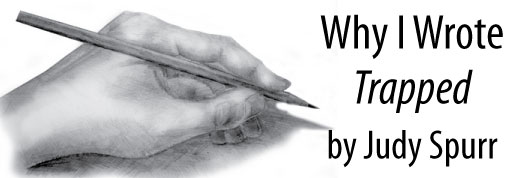An Author’s Perspective: Why I Wrote Trapped

 Judy Spurr is a retired teacher and former freelance journalist. She is the mother of four and grandmother of four. Spurr’s work with children with learning difficulties inspired her to write Trapped. She lives with her husband in Rockport, Massachusetts.
Judy Spurr is a retired teacher and former freelance journalist. She is the mother of four and grandmother of four. Spurr’s work with children with learning difficulties inspired her to write Trapped. She lives with her husband in Rockport, Massachusetts.
It took the better part of two years to write the book Trapped, from first draft, through several re-writes, edits, and the publishing process. Every dyslexic child who has read it has said, “That’s me!.” Likewise, the parents have said, “That’s my child.” Kate Anastasia, a special education teacher, wrote to me, “Trapped is such a real story..real kids, real school problems. Those of us who work with these students know their struggle all to well.”
As a parent, writer, and teacher of students with reading disabilities, I wanted to describe their struggles and emphasize the strengths that helped them triumph over their dyslexia. I also wanted to show that, like their peers, students who have learning disabilities play sports, listen to music, have friends, and share the trials of middle school.
Dyslexia is a brain-based language-learning disability. It is not a disease. Yet, it is often treated as such. Fellow students may subject dyslexic students to taunting, teasing, and outright bullying, making them feel they are failures. In certain instances, parents refuse the excellent remedial help that is available. They fear their child will be stigmatized or labeled. Classroom teachers may overlook curriculum modifications that can help the dyslexic student succeed.
Achievements in other areas, such as sports, music, art, or theater can build the confidence of dyslexic students, enabling them to combat the negative aspects of their learning disability.
 Michael Phelps, the winner of eight gold medals in the 2008 summer Olympics, actress Whoopi Goldberg, and actor Henry Winkler are just three of the numerous athletes, musicians, artists, explorers, medical professionals and people from all walks of life who are dyslexic. These individuals can serve as role models and may inspire students with learning difficulties to set higher goals for themselves.
Michael Phelps, the winner of eight gold medals in the 2008 summer Olympics, actress Whoopi Goldberg, and actor Henry Winkler are just three of the numerous athletes, musicians, artists, explorers, medical professionals and people from all walks of life who are dyslexic. These individuals can serve as role models and may inspire students with learning difficulties to set higher goals for themselves.
Many, but certainly not all dyslexic students, have special talents and abilities. One of my students, much like Jamie in Trapped, was an outstanding hockey player. When he came to me in sixth grade, he read at a second-grade level. His classmates were aware of this, but because of his success as an athlete, his peers accepted him. Another of my students was an accomplished artist; one a talented cook who went on to Johnson and Wales University in Rhode Island; another a talented musician.
For those of us who are parents, teachers, and administrators and responsible for educating dyslexic students, we must seek ways to guide our students to work from their strength whether it be music, art, or sports, or simply developing the art of friendship.
Although in Trapped I portrayed Jamie as a strong athlete, I hoped that young readers would see him as a good friend who is more alike than different from his classmates.
The majority of my students rose above their learning difficulties and have gone on to become successful in their professional and personal lives. However, many others, for a variety of reasons, have not. Their dyslexia has affected their adult lives and kept them from reaching their full potential.
In writing Trapped, I hoped that parents and teachers would recognize the importance of looking beyond the dyslexic students’ learning difficulties to identify and nurture their strengths.
******
 “A short, empathetic novel for middle-schoolers that addresses learning disabilities and bullying…nicely executed fiction with a neatly-resolved ending that will leave readers smiling.” –Kirkus Reviews
“A short, empathetic novel for middle-schoolers that addresses learning disabilities and bullying…nicely executed fiction with a neatly-resolved ending that will leave readers smiling.” –Kirkus Reviews
Spurr, a former reading teacher enters the real-life day to day struggles of kids with dyslexia and shows how friendships and perserverence can change a life. Read more about this book and learn about other books about dyslexia.
